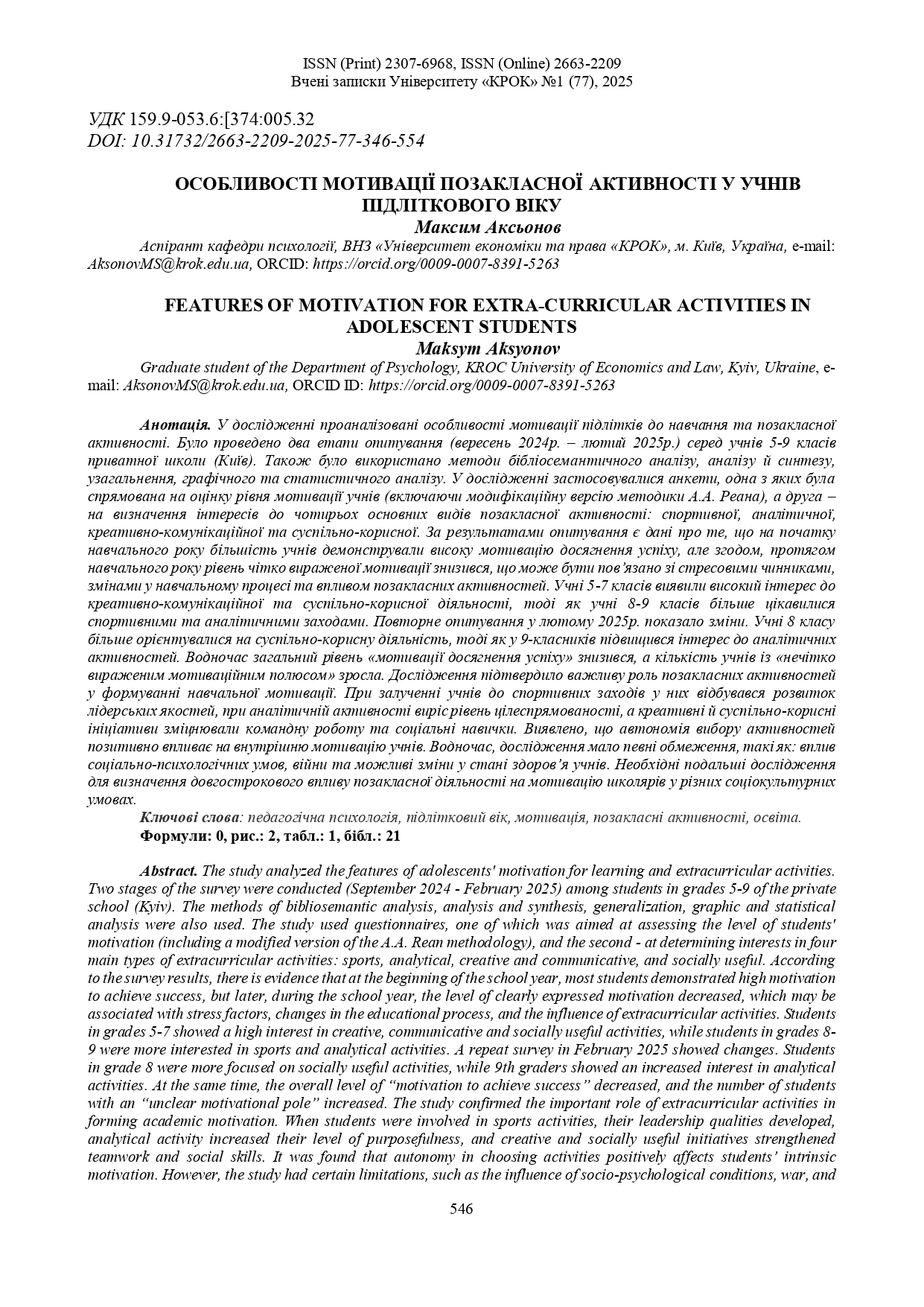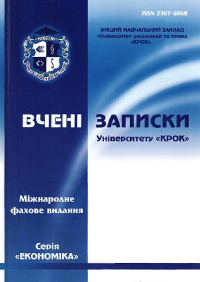FEATURES OF MOTIVATION FOR EXTRA-CURRICULAR ACTIVITIES IN ADOLESCENT STUDENTS
DOI:
https://doi.org/10.31732/2663-2209-2025-77-546-554Keywords:
educational psychology, adolescence, motivation, extracurricular activities, educationAbstract
The study analyzed the features of adolescents' motivation for learning and extracurricular activities. Two stages of the survey were conducted (September 2024 - February 2025) among students in grades 5-9 of the private school (Kyiv). The methods of bibliosemantic analysis, analysis and synthesis, generalization, graphic and statistical analysis were also used. The study used questionnaires, one of which was aimed at assessing the level of students' motivation (including a modified version of the A.A. Rean methodology), and the second - at determining interests in four main types of extracurricular activities: sports, analytical, creative and communicative, and socially useful. According to the survey results, there is evidence that at the beginning of the school year, most students demonstrated high motivation to achieve success, but later, during the school year, the level of clearly expressed motivation decreased, which may be associated with stress factors, changes in the educational process, and the influence of extracurricular activities. Students in grades 5-7 showed a high interest in creative, communicative and socially useful activities, while students in grades 8-9 were more interested in sports and analytical activities. A repeat survey in February 2025 showed changes. Students in grade 8 were more focused on socially useful activities, while 9th graders showed an increased interest in analytical activities. At the same time, the overall level of “motivation to achieve success” decreased, and the number of students with an “unclear motivational pole” increased. The study confirmed the important role of extracurricular activities in forming academic motivation. When students were involved in sports activities, their leadership qualities developed, analytical activity increased their level of purposefulness, and creative and socially useful initiatives strengthened teamwork and social skills. It was found that autonomy in choosing activities positively affects students’ intrinsic motivation. However, the study had certain limitations, such as the influence of socio-psychological conditions, war, and possible changes in the health status of students. Further research is needed to determine the long-term impact of extracurricular activities on student motivation in different socio-cultural settings.
Downloads
References
Гозак, С. В., Даниленко, Т. М., Єлізарова, О. Т., Станкевич, Т. В., & Парац, О. М. (2023). Особливості психологічної адаптації школярів під впливом різних форматів навчання під час війни.
Демчук, К. (2017). Порівняльний аналіз навчальної мотивації у підлітковому та ранньому юнацькому віці. Психологічні дослідження, 9, 42–44. http://eprints.zu.edu.ua/29956/1/Збірник_9_2017.pdf#page=42
За тиждень у столиці зареєстровано 9 424 нові випадки захворювання на грип та ГРВІ. Київ та міська влада січня 2025 р. URL: https://salo.li/e4DFCA9 (відвідано 28.02.25)
Калениченко, Р. А. (2023). Педагогічна психологія. Київський національний університет будівництва і архітектури. https://repositary.knuba.edu.ua/server/api/core/bitstreams/a7942d4d-eeba-47a9-9f41-2406b5903bd5/content (Оригінал опубліковано 2023 р.)
Никоненко, О., & Лимарева, І. (2024). Соціально-психологічні чинники формування мотивації досягнень в умовах війни. Вчені записки Університету «КРОК», 1(73), 244–253. https://doi.org/10.31732/2663-2209-2024-73-244-253
Сингаївська, І., & Глуговська, О. (2024). Особливості психологічної комптентності вчителя в роботі з підлітками під час війни. Вчені записки Університету «КРОК», 4(76), 319–337. https://doi.org/10.31732/2663-2209-2024-76-320-337
Чаус, Г.Г., Романець, О.А., & Кочерга Є.В. (2022). Діяльнісний підхід як мотивація здобувачів освіти до продуктивного навчання. Хмельницький: МЦНД, 421 с.
Berger, C., Deutsch, N., Cuadros, O., Franco, E., Rojas, M., Roux, G., & Sánchez, F. (2020b). Adolescent peer processes in extracurricular activities: Identifying developmental opportunities. Children and Youth Services Review, 118, 105457. https://doi.org/10.1016/j.childyouth.2020.105457
Bodnar H., Barchi B. Psychological features of student self-education work of creative specialties. (2021). Матеріали Всеукраїнської науково-практичної інтернет-конференції «Вітчизняна наука на зламі епох: проблеми та перспективи розвитку»: Зб. наук. праць. Переяслав, 67, 236 с.
Eccles, J. S., Barber, B. L., Stone, M., & Hunt, J. (2003). Extracurricular activities and adolescent development. Journal of Social Issues, 59(4), 865–889. https://doi.org/10.1046/j.0022-4537.2003.00095.x
Fielding, J., Geiger, V., Miller, J., Bruder, R., Towara, U., & Ratnayake, I. (2022). Using situated expectancy value theory to explore initial teacher education students' motivation to engage with challenging mathematical tasks. Teaching and Teacher Education, 113, 103663. https://doi.org/10.1016/j.tate.2022.103663
Filgona, J., Sakiyo, J., Gwany, D. M., & Okoronka, A. U. (2020). Motivation in learning. Asian Journal of Education and Social Studies, 16–37. https://doi.org/10.9734/ajess/2020/v10i430273
Fishbach, A., & Woolley, K. (2022). The structure of intrinsic motivation. Annual Review of Organizational Psychology and Organizational Behavior, 9(1), 339–363. https://doi.org/10.1146/annurev-orgpsych-012420-091122
Haegele, J. A., Aigner, C., & Healy, S. (2020). Extracurricular activities and bullying among children and adolescents with disabilities. Maternal and Child Health Journal, 24(3), 310–318. https://doi.org/10.1007/s10995-019-02866-6
Jucan, D. (2023). Extracurricular activities theoretical and practical approaches for primary and preschool cycles. У 10th international conference education, reflection, development. European Publisher. https://doi.org/10.15405/epes.23056.19
Mahoney, J. L. (2000). School extracurricular activity participation as a moderator in the development of antisocial patterns. Child Development, 71(2), 502–516. https://doi.org/10.1111/1467-8624.00160
Oberle, E., Ji, X. R., Guhn, M., Schonert-Reichl, K. A., & Gadermann, A. M. (2019). Benefits of extracurricular participation in early adolescence: Associations with peer belonging and mental health. Journal of youth and adolescence, 48(11), 2255–2270.
Scales, P. C., Boekel, M., Pekel, K., Syversten, A. K., & Roehlkepartain E. C. (2020). Effects of developmental relationships with teachers on middle-school students’ motivation and performance. Psychology in the Schools, 57, 4.
Shin, J., & Grant, A. M. (2019). Bored by interest: How intrinsic motivation in one task can reduce performance on other tasks. Academy of Management Journal, 62(2), 415–436. https://doi.org/10.5465/amj.2017.0735
Taylor, G., Jungert, T., Mageau, G. A., Schattke, K., Dedic, H., Rosenfield, S., & Koestner, R. (2014). A self-determination theory approach to predicting school achievement over time: The unique role of intrinsic motivation. Contemporary educational psychology, 39(4), 342–358.
Zakhir, M. (2019). Extracurricular activities in tefl classes. Lifelong Education, 7(2). https://doi.org/10.25749/sis.17590

Downloads
Published
How to Cite
Issue
Section
License

This work is licensed under a Creative Commons Attribution-NonCommercial 4.0 International License.

